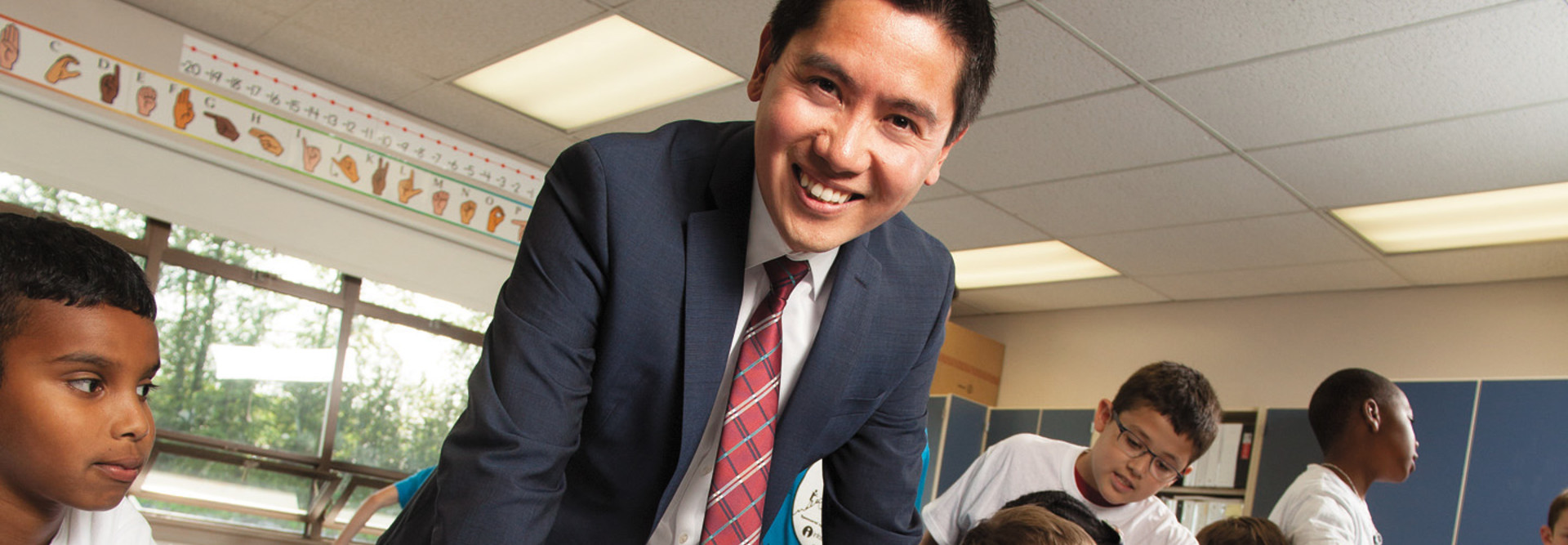District Leaders as Technology Evangelists
In January 2010, Washington's Kent School District expanded its annual Technology Expo to include exhibits by businesses and local institutions. The goal was to more effectively demonstrate why classroom technology matters beyond the classroom doors.
"The intent was to go beyond showcasing classroom technologies, to show our families how the skills we're teaching our kids today are being leveraged in the workplace every day," says Thuan Nguyen, chief information and digital strategy officer for the 41-school district southeast of Seattle.
After moving the revamped Technology Expo to a large event center and securing sponsorships from businesses, annual attendance jumped from a few hundred to more than 5,000 in 2014. One of this year's most popular attractions was a police car showcasing technology that officers use on the job, Nguyen says. But attendees also got to see the work of middle school students who used Google SketchUp to design a skate park alongside an architectural firm exhibit showing how AutoCAD is used to design buildings.
"If you look at the 21st century skills framework, it's about collaboration, communication skills and problem solving," Nguyen says. "Those skills are needed in all kinds of careers. We wanted to heighten the visibility of that message."
Spreading the Word
Like his counterparts in districts across the country, Nguyen increasingly finds that his job extends beyond the bits and bytes of IT, to include informing and engaging the community in technology-driven learning. Parents and taxpayers need — and expect — to know how investments in technology are paying off for their children.
KSD's expositions are part of a wide-ranging communications effort that includes annual "Welcome Back" videos, produced by the IT department and students, which highlight technology and other district initiatives. Emails to parents, newsletters and a robust website offer information about technology and other projects in the schools.
"We don't wait until we need funding to inform the community of the work we're doing. We want to keep people involved every step of the way," Nguyen says, noting that the strategy has yielded results: Independent surveys indicate that technology in schools is a top educational priority throughout the district community.
The same is true for Ysleta Independent School District in El Paso, Texas, where a communications plan is part of every major technology initiative.
"We ask ourselves how we're going to market this to our communities," says Micha Villarreal, director of innovative learning. "We always want people to get the information in a timely and effective way because it's important for them to know what's going on in the schools."
The district of 42,000 students is active on social media and maintains its own YouTube channel, for example.
11% The approximate percentage of work time that K–12 chief technology officers spend on stakeholder relations*
SOURCE: "K–12 IT Leadership Survey" (Consortium for School Networking, March 2014)
YISD also organizes an annual Teachers Networking Technology and Content Conference, attended primarily by district staff and educators from around the region. Villarreal says the conference is open to the entire community, however, and that high school students help organize — and often present at — the event, now in its 14th year.
The YISD website is a dynamic communications tool as well. Every day, its operators collect stories and videos from district schools about programs, events and technology and make them available to the community, says Chief Technology Officer Gloria Chavez.
"A story will start on the website and then go to Facebook or Twitter," she says. "If it's a video, it could end up on YouTube as our video of the week."
According to Villarreal, the district's aim is to build a digital community in order to spread information and encourage collaboration. In this way, technology can enhance learning throughout its 62 schools.
"We advocate for [all stakeholders] to provide students with the opportunities to be competitive with their peers," she says. "Part of that is technology and the skills involved in using it."
Project-By-Project Persuasion
New Jersey's West Windsor–Plainsboro Regional School District also takes a targeted approach to how it communicates with the communities it serves. In addition to regularly scheduled presentations to all district stakeholders, Director of Technology Rick Cave and his staff meet with parents to discuss new initiatives and explain how technology will be used to improve learning. Email updates, newsletters and a website offer other channels for important information.
Attracting support for classroom technology isn't a problem for the 10-school district, which has a motivated student body (roughly 10,000 strong) that goes on to elite universities. The biggest communications challenge, Cave says, is persuading parents and other stakeholders that technology changes the instructional model for the better.
"Our community is pro-technology, but when parents found out that teachers were spending much less time presenting information, they pushed back," he explains. "Our job is to persuade them that in order for technology to have an impact, kids have to be using it. The shift has to be to students owning their own learning. That's the message on which we're focusing our efforts, and we deliver it project by project."
Delivering the message that technology can make education more effective for all students has become part of most educational technologists' jobs, in fact.
"Parents need to know about their children's education," KSD's Nguyen says. "We have to keep community members informed so they can feel confident that their dollars are well spent and that their students are prepared for their futures."
Tech For All
Building a digital community requires more than just spreading the word about technology in the classroom. Districts also need to expand technology access to the families they serve, says Thuan Nguyen, chief information and digital strategy officer for the Kent (Wash.) School District.
For many years, KSD has refurbished its older computers, negotiated with manufacturers for free software and offered the machines to eligible families. Staff in the multilingual district also provide basic computer training in families' native languages.
When the district implemented a one-to-one computer program for grades seven through 12, officials tried various ways of providing Internet access to homes in the sprawling district — sometimes paying for the service or loaning Wi-Fi hotspots to KSD families. Today, it has installed kiosks in the area's low-income housing facilities, from which parents can access the district website and apps that provide information about schools and student progress. The kiosks double as wireless hotspots for students' one-to-one devices. The district also has enlisted local businesses to give students free Wi-Fi access.
In the same community-building spirit, Ysleta Independent School District opens many of its libraries and computer labs to parents. Some seek help searching the web; others who lack Internet access at home use these resources to complete online job applications, says Micha Villarreal, director of innovative learning for the El Paso, Texas, district.
"A couple of campuses offer Rosetta Stone software to help them learn English," she adds. "We want parents to become more comfortable with technology and have access to it too."








